The Role of Vineyards in the Carbon Balance Throughout Italy
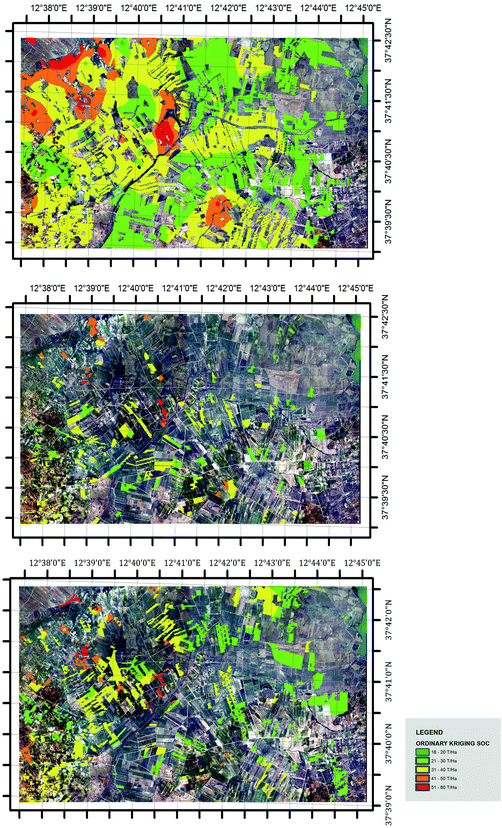
Fig. 11.1
Selected vineyard sites (circle Eddy Covariance sites; square Sicilian site for land use change studies)
11.1.1 Negrisia (Ponte di Piave, TV) Site
The FLUXNET station of Negrisia has been established in July 2005 in an extensive vineyard located close to Ponte di Piave (see Sect. 2.2.14 for a description). The vineyard is well suited for MODIS satellite platform observations. The station was intended for long-term monitoring of energy, water and CO2 fluxes on a representative vineyard for North-Eastern Italy and has been operated continuously until 2011, with few gaps due to power failures or sensor maintenance. Leaf area development was monitored regularly both by direct, destructive measurements on a sample of shoots, and by indirect, optical method, using a LiCor LAI-2000 canopy analyzer. Extensive biometrical sampling of leaves, shoots, trunks and roots has been carried out to provide independent measurements of vine growth dynamics and biomass partitioning.
The Eddy Covariance equipment is based on a 3-dimensional ultrasonic anemometer (Metek USA-1) and an open-path IR gas analyzer (LiCor LI-7500), both logged at 20 Hz by a low-power industrial PC. Ancillary measurements of net radiation (CNR-1, Kipp and Zonen) and basic meteorological parameters (air temperature and humidity, barometric pressure, rainfall, etc.) are measured every second and averaged every 30 min by a CR23X Campbell datalogger. Eddy Covariance data were processed according to the standard EUROFLUX methodology (Aubinet et al. 2000). Data quality check has been performed according to Foken and Wichura (1996) and gap-filling following Desai et al. (2005).
Following the set up of the station, the Negrisia vineyard proved to be a strong carbon sink. Data for 2009 (Fig. 11.2) showed a rapid increase of NEE already before budbreak, due to the increased activity of the grass cover, as soon as the temperature turned milder (Fig. 11.3). The quick development of the vine canopy further increased carbon absorption up to a maximum decadal NEE of 50 g C m−2, which occurred around veraison. Leaf senescence and fall brought a steep decrease of NEE by the end of October. However, the system never showed a net release of carbon, because of the residual activity of the grass cover even during wintertime. Obviously, this behaviour strongly reflects both the adequate water availability (the vineyard never experienced significant stress, because of the generally high water table of the area) and the mild temperature (seldom below 0 °C). The annual total NEE (814 g C m−2) suitably matched the biometrical measurements. Yield represented roughly 20 % of NEE and therefore Negrisia vineyard behaved as a carbon sink even after harvest. Orchards and vineyards seem to be good candidates for mitigation practices, at least where an adequate water supply allows the establishment of a grass cover and cultivation is reduced or suppressed.
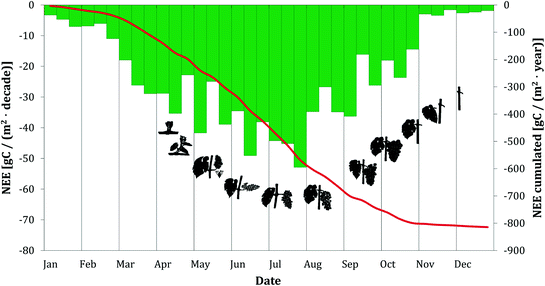
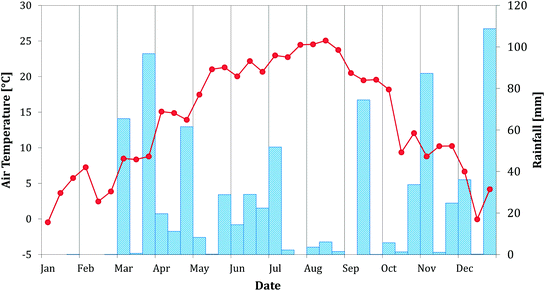

Fig. 11.2
Yearly course of decadal and cumulated NEE at the Negresia site, related to phenological stages

Fig. 11.3
Basic meteorological measurements for the site of Negrisia
11.1.2 Valle dell’Adige (Mezzolombardo, TN) Site
The Mezzolombardo site is located in a vineyard in the Valle dell’Adige (Fig. 11.1; see Sect. 2.2.25 for a description).
Mass and energy fluxes have been continuously measured since 2008 at the site with an Eddy Covariance system mounted at a height of 7 m. The system consists of a Gill R3 3-D ultrasonic anemometer (Gill Instruments Ltd., Lymington, UK) and a Li-Cor 7500 open-path fast response infrared gas analyser (IRGA) (Li-Cor Inc., Lincoln, Nebraska, USA). Raw data are recorded at a frequency of 20 Hz and stored every 30 min into separate files with the Edisol software. Along with flux measurements, the tower is equipped with sensors for the measurement of standard meteorological parameters: short and long-wave radiation components (Kipp and Zonen CNR1, Delft, The Netherlands), photosynthetic active radiation (LiCOR 190 SA, Lincoln, Nebraska, USA), global solar radiation (LiCOR 200 SA, Lincoln, Nebraska, USA), direct and diffused radiation (BF3, Delta-T Devices, UK), air humidity, air temperature (Rotronic MP103A, Crawley, UK) and precipitation (Young 52202H, Traverse City, Michigan, USA). Soil temperature is measured at depths of 2, 5, 10, 20 and 50 cm (STP01, Hukseflux, Delft, The Netherlands), while volumetric soil water content is measured at 10 and 20 cm depths with CS615 reflectometers (Campbell Scientific Inc., Logan, Utah, USA). All meteorological variables are recorded at 1-min intervals and averaged over 30 min; both 1-min recordings and averages are stored on a CR23X datalogger (Campbell Scientific Inc., Logan, Utah, USA).
Measured raw data were processed using the EdiRe software (R. Clement, University of Edinburgh, UK) to obtain energy and mass fluxes. Flux computation was performed following standard procedures (Aubinet et al. 2000), with data quality control according to Mauder and Foken (2011). Gaps in the dataset were filled using Falge et al. (2001a,b) and Reichstein et al. (2005) methodology.
The average air temperature value for 2009 was 13.5 °C, ranging from −4.5 (January 04) to 26.1 °C (August 18) (Fig. 11.4). Precipitation was mainly distributed during winter and autumn with a total amount of 737.7 mm. The 2009 was characterized by high temperature and low precipitation, in particular during the growing season, in comparison with the 30-years average.
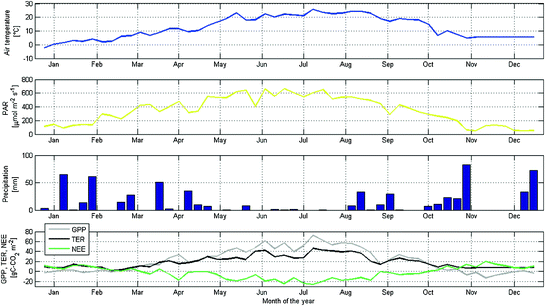

Fig. 11.4
Average air temperature, photosynthetic active radiation (PAR), cumulative precipitation, NEE, GPP and TER in the Mezzolombardo site
The growing season starts in the middle of March and lasts until the end of September with maximum carbon dioxide uptake at the end of April (because of high radiation and water availability) and in July. In this period, the ecosystem adsorbs more than 200 g C m−2 (Fig. 11.4). During the winter season (from October to March the vineyard acted as a C source. The radiation, more than temperature and precipitation, seems to be the main factor that drives carbon fluxes in this vineyard ecosystem (Fig. 11.4). At an annual scale, the vineyard was a net C sink, with cumulated NEE value of 145 g C m−2 y−1 (Fig. 11.5).
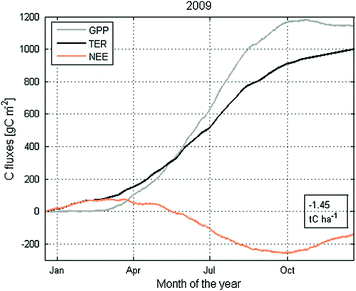

Fig. 11.5
Annual cumulative values of NEE, GPP and TER at the Mezzolombardo site
11.1.3 Serdiana (Cagliari) Site
The experimental site is located within the Company Argiolas Winery near Serdiana, Cagliari, Italy (39°21′43″N, 9°07′26″E, 112 m asl) (Fig. 11.1). The Vermentino variety grapevines, trained in a Guyot system, are oriented in east-west rows with 0.8 m between plants and 2.0 m between rows. The vegetation is about 2.0 m tall with about 50 % ground shading of the clay soil.
A meteorological station was established nearby to measure the main meteorological variables and data were transmitted by remote telecommunication system using a GPRS web protocol. An Eddy Covariance station was set up to continuously monitor energy and mass fluxes from June to December 2009. A sonic anemometer (CSAT3, Campbell Scientific, Logan, UT, USA) and an open-path gas analyzer (Li-7500, Li-cor, Lincoln, NE, USA) were used to measure vertical wind speed and water vapour and CO2